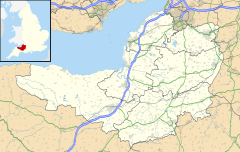Hinton Charterhouse
| Hinton Charterhouse | |
|---|---|
 Pub, post office & general store in village centre |
|
| Hinton Charterhouse shown within Somerset | |
| Population | 515 |
| OS grid reference | ST775585 |
| Unitary authority | |
| Ceremonial county | |
| Region | |
| Country | England |
| Sovereign state | United Kingdom |
| Postcode district | BA2 |
| Police | Avon and Somerset |
| Fire | Avon |
| Ambulance | South Western |
| EU Parliament | South West England |
| UK Parliament | |
Hinton Charterhouse is a small village and civil parish in the Bath and North East Somerset unitary authority, Somerset, England. The parish, which includes the village of Midford, has a population of 515.
The village is served by two pubs: the Stag Inn and the Rose & Crown, a vehicle repair garage; Charterhouse Works and Fortnum & Jacob, the local stores and post office.
The local paper is the occasionally published Hinton Bugler.
The parish of Charterhouse Hinton was part of the Wellow Hundred.
The chapter house with library and dovecote above, of the former Carthusian Hinton Priory dates from 1232 and is a Grade I listed building. The priory was founded in 1232 by Ela, Countess of Salisbury, who also founded Lacock Abbey.
During the Second World War, GHQ Line ran just to the north of Hinton Charterhouse. At (Hedge) Hog Wood remains of an anti-tank ditch and other trenchworks can still be seen. These rare survivors as well as rather more robust pillboxes were constructed as a part of British anti-invasion preparations.
The Grade II listed former village school is now a private residence.
The parish council has responsibility for local issues, including setting an annual precept (local rate) to cover the council’s operating costs and producing annual accounts for public scrutiny. The parish council evaluates local planning applications and works with the local police, district council officers, and neighbourhood watch groups on matters of crime, security, and traffic. The parish council's role also includes initiating projects for the maintenance and repair of parish facilities, such as the village hall or community centre, playing fields and playgrounds, as well as consulting with the district council on the maintenance, repair, and improvement of highways, drainage, footpaths, public transport, and street cleaning. Conservation matters (including trees and listed buildings) and environmental issues are also of interest to the council.
...
Wikipedia

